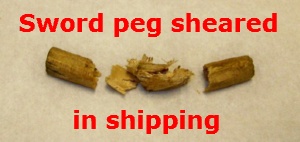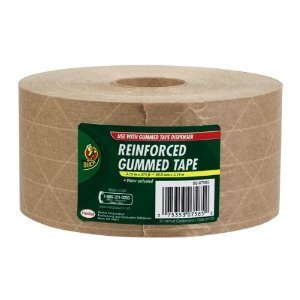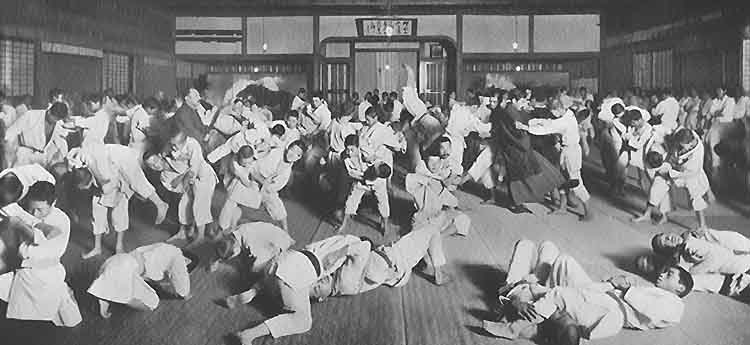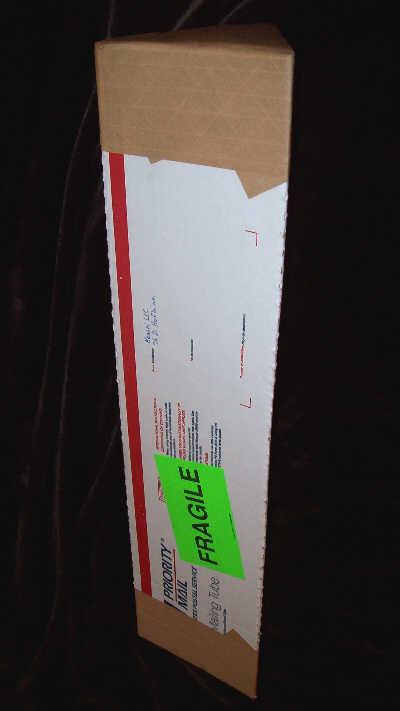How to Protect a Japanese Sword Blade in Shipping
www.theswordpolisher.com
| |||||||||||
TRACKING LINKS > |  | ||||||||||
| The
best
defense for a Japanese sword when shipping is a sturdy well
constructed package. A strong package along with a reliable
carrier is essential to protecting your valued sword. REGISTERED mail is the
most secure option and should be used whenever possible.
Insurance
is fine, but it will not replace your one of a kind blade if it is lost
or damaged in shipping. Shipping insurance can also be difficult
to collect on. You must have proof of value such as a bill of
sale or a written appraisal from a professional third party
appraiser. To complicate matters further your blade will be
considerably more
valuable after being polished, so any receipt or appraisal you have
will be out of date. Therefore your best bet on getting your
sword shipped without loss is a strong package. I strongly advise against shipping a fully mounted blade unnecessarily. I only need the blade not the entire mounting. I can not even tell you how many immaculate brand new koshirae (traditional mountings) or rare antique koshirae I've seen damaged in shipping over the last 30 years. A sturdy shira-saya with a strong peg is good for shipping if you have one. If not, a very safe board mounting can be easily made. A shira-saya or board mounted blade is very difficult to damage in shipping. It is also much less attractive to a potential thief. Special steps must be taken when shipping an unmounted blade, but it can be done very safely and reliably. A bare blade will also give you a smaller and lighter package that will cost much less to ship. To ship just the blade, take the blade out of the mounting and wrap it in paper such as newspaper to prevent it from being scuffed or finger printed. Wrap it tightly to prevent it from moving around. The next step is to mount the blade onto a wooden board that is longer then the overall length of the blade. A common 1"x2" to 1"x4" works very well. Drill a hole in the board and put a heavy wire (at least 12 gauge solid) or nylon rope or similar through the hole in the board and the hole in the tang. THIS IS ESSENTIAL FOR SHIPPING AN UNMOUNTED BLADE! Further strap the blade onto the board with LOTS of heavy strapping tape. You need a package that can withstand being dropped on its end from a height of 2 or 3 feet. Being dropped on its end by postal workers will send the blade crashing forward with the force of a hammer blow.  A bare blade strapped to a board in this manner can actually be much safer overall then a blade shipped in shira-saya or other mounting. It prevents the blade from vibrating or rattling in its saya during shipping and scuffing up the new polish. You also don't have to worry about the peg breaking or saya splitting. It is absolutely NOT attractive to a potential thief, especially if they don't know anything about Japanese swords. Bottom line, a board mounting is the safest and most secure method of shipping a Japanese blade, with a strong shira-saya coming in second, and a full traditional koshirae not being recommended at all. Once you have a sturdy shira-saya or board mounting you need a shipping carton. FedEx and the Post Office both have 38" triangular shipping tubes that are very good for unmounted blades katana length and under. You can overlap and combine 2 of the tubes to make 1 longer tube if needed. FedEx also has much larger size shipping tubes available for sale. The heavy cardboard core from a carpet roll or some light weight 4" pvc "sewer" pipe can also make a good shipping tube. Wrap your blade in bubble wrap and seal it tightly in your tube for safe shipping. Make sure that there is at least some cushioning in the end of the tube such as crumpled up newspaper for when the package is dropped on its end. Finally you have to choose a carrier and this is essential. Registered U.S. Mail or U.S. Express Mail with insurance are best. Insured US Priority Mail with signature required or FedEx with direct signature required can also be used, but are much less secure. REGISTERED U.S. MAIL is the most secure. The package stays locked up and has to be signed for. It also has the least expensive insurance because it is very unusual for a Registered package to be lost or damaged. Registered packages do not even travel in the normal mail stream and receive specialized handling throughout. The downside is that it can be very slow. Post-covid it can take anywhere from 4 to 15 days for a large Registered package to go cross country due to all the extra layers of security and staffing shortages at the post office. Registered mail does have special packaging requirements. You must have a "virgin" package. This is a package with no old postage, address, or other marks on it. The package also must be sealed with "paper tape". This is the kind that you have to wet and stick. They have these requirements so they can put "tamper seals" on the package. Brown package wrapping paper and paper tape can be found in the packaging isle of most large office supply stores, package shipping centers, and some hardware stores.  This is the kind of tape you want for Registered US mail shipping. Fiberglass reinforced water activated gummed paper tape. The easiest way to wet a strip of this type of tape is to run it across the top of a wet sponge. Click on the image to buy this tape from Amazon. PRIORITY MAIL WITH INSURANCE is an acceptable option. There are no special packaging requirements. Cross country shipping usually takes about 4 to 5 days. You MUST have over $500 insurance or the package will not require a signature and may be left unattended. Priority mail with insurance will generally cost more than Registered mail because the insurance is much more expensive due to the higher rate of loss and damage. U.S. EXPRESS MAIL with insurance is an over night service from the post office. It can cost $100 to $200 to ship a large sword with insurance, but the package moves very fast with good tracking which reduces the opportunity for mishaps. You can use any type of tape to seal an Express mail package. FedEx is not really recommended, but can be used successfully if you prefer. You can only insure an antique Japanese sword for $500 max with FedEx. They also consider all damage that occurs during shipping as caused by inadequate packaging and will not pay any claims, so appropriate insurance is NOT available through FedEx. They also insist on opening and inspecting ALL packages valued at over $499. This pretty much guarantees that swords with higher declared values will be finger printed, scuffed up or otherwise buggered with by some back room box handler, so you really must declare an artificially low value for FedEx shipping. They do have the best tracking and the packages move fast which makes them less likely to run into trouble, but I do know a few people who have had their FedEx packages stolen. You can use any type of tape to seal a FedEx package. UPS is not a good option. Finally, your shipping choice MUST REQUIRE a DIRECT SIGNATURE! Delivery people are much more likely to deliver a package to the correct address if they are required to get a signature. Delivery confirmation is NOT enough. With delivery confirmation, the carrier pushes a button claiming that the package was delivered, but there is no proof that the package was actually delivered or that it was delivered to the correct address or that it wasn't stolen off a front porch after being left unattended. SWORD SHIPPING RULES -DO NOT use a gun case to ship swords. The foam inserts do not hold swords securely and you are just asking to have your package stopped and opened.Make sure to NEVER use a retail shipping outlet, one of those chain stores that does all the packaging and shipping for you. One of my clients did this and they not only stole the contents of his original package, but sent a completely different box in its place. Loss or theft by a third party retail shipper is not covered by shipping insurance. TAKE PICTURES of the package before shipping. This can be used to help identify the package if lost and to prove that it was correctly packaged and labeled if necessary. Finally, please TRIPLE CHECK THE MAILING ADDRESS!!! If you send your package to the wrong address, you are not likely to get it back. Every sword I have ever seen lost or damaged in shipping was the result of the shipper either packaging badly or going cheap on the shipping (no tracking and no signature required). Follow the above guide lines and you can make sure that your swords will arrive safely. For example, over the last 30+ years of full time polishing, I have never had a sword that I packed and shipped lost or damaged in any way. David S. Hofhine |
 | ||||||||||

Puppy announces when the mail arrives!
Please note,
the blades featured on this web site
are not currently in
my possession, do not belong to me and are not for sale as far as I
know. An
absolute minimum number of blades (usually just one or two unmounted
and unpolished) are kept on
hand at all times to minimize liability. -David Hofhine












Please feel free to contact me for more information at the following address:
E-mail: davidhofhine@att.net
Copyright David Hofhine, Kensei LLC




